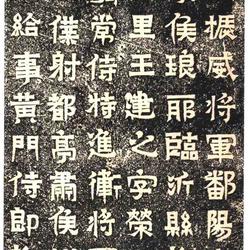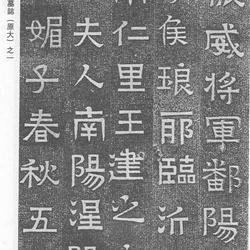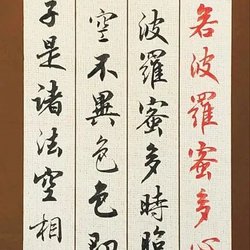
"Wang Ji's Epitaph" of the Eastern Jin Dynasty was inscribed in the third year of Taihe in the Eastern Jin Dynasty (AD 368). It was unearthed in 2003 from Wang Bin's family cemetery in Xiangshan, Nanjing, Jiangsu. Wang Qianzhi is a cousin of the great calligrapher Wang Xizhi. Wang Qianzhi's epitaph contains 88 characters in official script style with regular script.
[Inscription]:
Before the Jin Dynasty, Danyang ordered Cavalry Commander Langye to be named Linyi Duxiang Nanli. Wang Renzhi was named Shaoji and died on December 21, the second year of Taihe in the Spring and Autumn Period. His wife Cao's name was Meirong Shi Lujiang, and her character Zuqing was copied from the male character Jingdao.
Appendix: The debate over the authenticity of Wang Qian’s epitaph and the “Lanting Preface”
■Jiangsu Wang Bingyi
In the autumn of 2003, archaeologists from the Nanjing Museum excavated three tombs of the Wang family, a wealthy family in the Eastern Jin Dynasty during the Six Dynasties period, in Xiangshan, a northern suburb, and unearthed a number of cultural relics and treasures that had never been found in Eastern Jin tombs before. The most valuable thing is that three epitaphs of great artistic value were unearthed. They are rare masterpieces of epitaph calligraphy from the Six Dynasties and provide new evidence for the great debate on the authenticity of the calligraphy of "Lanting Preface" -
These three Wang family tombs are located on the southern slopes of Xiangshan Mountain in Nanjing. The tombstones are about 10 meters above the ground. Epitaphs were unearthed from all three tombs. It can be seen that the owner of tomb No. 8 is Wang Qianzhi, the Danyang Order and Cavalry Commander of the Eastern Jin Dynasty. The owner of tomb No. 9 is Wang Jianzhi, General Zhenwei of the Eastern Jin Dynasty. Among them, Wang Qianzhi is the cousin of the great calligrapher Wang Xizhi. Wang Qianzhi's epitaph has a total of 88 characters in official script style with regular script. Wang Jianzhi's epitaph is in official script style with seal characters. According to archaeological experts: Xiangshan is the family cemetery of Pushe Wang Bin, the minister in the early Eastern Jin Dynasty. Wang Bin is Wang Xizhi's uncle. In the 1960s and 1970s, seven tombs were excavated in the Wang Bin family cemetery in Xiangshan, Nanjing. Among them, the epitaph of Wang Xingzhi, Wang Xizhi's cousin, was found in tomb No. 7, which triggered the famous calligrapher Gao Ershi and the academic circle of Chinese literature and history. The authoritative Guo Moruo influenced the "Lanting Debate" across the country. One of the focuses of the debate was whether regular script existed during the Eastern Jin Dynasty: the unearthing of the epitaphs of Wang Renzhi and Wang Jianzhi is of great significance for in-depth research and exploration of the Six Dynasties calligraphy and the evolution of Chinese calligraphy. Objectively supports the basic argument of being suitable for high school students.
In the mid-1960s, Guo Moruo questioned the authenticity of the famous calligraphy "Lanting Preface" by Wang Xizhi, a great calligrapher of the Jin Dynasty, triggering an academic debate that attracted the world's attention. Mr. Guo is knowledgeable and well-known at home and abroad. He prefers to establish new theories and write articles on reversal of verdicts in history, such as reversal of verdicts for historical figures such as Cao Cao and Wu Zetian. There is nothing wrong with establishing a new family. In early 1965, Guo Laozai proposed in his article "On the Authenticity of the "Lanting Preface" from the Excavation of Wang Dun Xie Kun's Epitaph": After his research and verification, the "Lanting Preface" that has always been regarded as Wang Xizhi's masterpiece is actually from the Sui Dynasty. A pseudonym written by the monk Zhiyong. After this article was published in "Guangming Daily", it attracted widespread attention in the literary and historical circles and even in the sinology circles of Japan and South Korea. There were some supporters and even more dissenters. Many experts and scholars in my country disagree with Guo Wen's conclusion and think it is too subjective and arbitrary. But he lacked the courage to publicly write an article to argue with Guo Moruo. Only Mr. Gao Ershi, a librarian of the Jiangsu Provincial Museum of Culture and History, wrote a special article "A Refutation of the Authenticity of the "Lanting Preface"", citing a variety of historical materials to refute Guo's article one by one.
Shi Shi, a native of Dongtai, Jiangsu Province, was born in 1903 in the second year of high school. He first attended a rural school. He came to Nanjing in 1910 and studied Chinese literature and calligraphy under Gu Yun, a famous scholar and one of the seven poets in Jinling in the late Qing Dynasty. In the early 1930s, he was already somewhat famous. He was a poet, scholar and calligrapher. He once served as secretary to Chen Shuren, chairman of the Overseas Chinese Affairs Committee of the National Government. He is good at cursive calligraphy and has extraordinary skills. His calligraphy is wild and unrestrained and unique, and he is highly praised by many famous calligraphers. In the second year of high school, he is rigorous in his studies, honest, ethical, stubborn, and has the courage to adhere to objective truth and explore. Ignoring the advice of his friends, he asked his early mentor, Mr. Zhang Shizhao, to forward the manuscript to Chairman Mao Zedong for review in order to receive fair treatment. Chairman Mao, who was busy with everything, followed this academic debate with great interest. He wrote a letter to the heads of relevant departments, saying that debate should be allowed and different opinions should be allowed to exist. In this way, Shi Shi's article in the second year of high school was published in the "Literature, History and Philosophy" section of Guangming Daily in June 1965, once again attracting the attention of the literary and historical circles and even the majority of literary and history lovers. Two months later, "Cultural Relics" magazine photocopied and published Chairman Mao's letter and Gao Ershi's article. (In recent years, an article has revealed that Mao Zedong actually agreed with Guo Moruo's views, and it was a blessing that Shi Shi, a sophomore in high school, did not get into trouble for being involved in the controversy.) Guo Moruo maintained silence for a period of time. In 1972, Guo Moruo wrote another article in the "Cultural Relics" magazine "Fragments of the Jin Manuscript "Three Kingdoms" Unearthed in Xinjiang". In this article, he mentioned the old words again and once again spent a lot of space talking about the "Lanting Preface" post. He still believed that this eternal The name post must be fake. It was during the Cultural Revolution, and people were silent. However, when he was a sophomore in high school, he was still unconvinced and wrote "Reconsideration of the Authenticity of the "Lanting Preface" Post" at his home in Nanjing. He wanted to continue to argue, but could not publish it. A year later, he completed another book, "The Preface to Lanting", with a total of 110,000 words, but it was impossible to publish it. In the context of that era, this debate could not be settled. A few years later, Gao Ershi and Guo Moruo also passed away one after another.
In recent years, there have been debates over the authenticity of the "Lanting Preface" post. It seems that the view that the "Lanting Preface" post is an authentic work by the calligrapher Wang Xizhi prevails. In fact, six years ago, the epitaph of Gao Song, a famous official of the Eastern Jin Dynasty who was the contemporary of Wang Xizhi, was discovered in Guojiashan, the northern suburb of Nanjing. The official regular script style has attracted the attention of some people in the calligraphy circle. The unearthing of the epitaphs of Wang Rizhi and Wang Jianzhi further illustrates the problem. . This is undoubtedly a very meaningful thing.




















